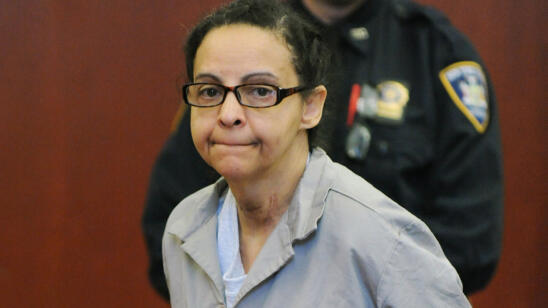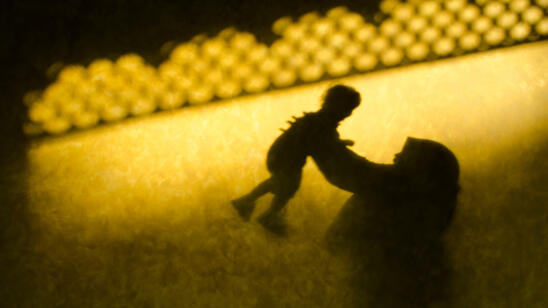On February 4, 1997, Louise Woodward called 911 in Newton, Massachusetts, to report a baby who was “barely breathing.” The infant was 8-month-old Matthew Eappen.
Matthew was comatose when he arrived at Children’s Hospital in Boston. His injuries included a skull fracture, subdural hematoma (bleeding in the space between the skull and brain) and retinal hemorrhaging (bleeding at the back of his eyes). He had massive brain damage. Doctors concluded he was a victim of shaken baby syndrome.
Woodward, a 19-year-old from England working as an au pair during a gap year after high school, was caring for Matthew and his 2-year-old brother when the baby became unresponsive. She was quickly accused of violently shaking Matthew and was arrested on February 5, 1997.
[Stream episodes of American Justice in the A&E App.]
Matthew was taken off life support on February 9, 1997. Woodward, who denied hurting the baby, was charged with first-degree murder in March.
Here is what happened during and after Woodward’s trial, why the case remains controversial and what Woodward’s life is like today.
Louise Woodward’s Trial
Woodward’s October 1997 trial became a sensation in both the United States and the United Kingdom, where trials were not televised at the time.
The prosecution stated Matthew had three particularly significant injuries: subdural hematoma, bleeding at the back of his eyes and brain swelling. According to expert medical testimony, this “triad” of symptoms was proof Matthew had been violently shaken.
The prosecution also said Matthew’s head had been slammed on a hard surface.
Prosecutors accused Woodward of preferring fun in Boston to childcare duties. Matthew’s parents, Drs. Deborah and Sunil Eappen, felt that Woodward, who’d left a previous au pair job that had an 11 p.m. curfew, often stayed out too late.
Woodward’s defense contended that aggravation of an older accidental injury had caused Matthew’s death.
The defense’s medical experts argued that Matthew’s skull fracture showed signs of healing, so the injury had been sustained weeks before. Expert testimony also declared the blood clots from Matthew’s brain were three weeks old, and the baby’s wrist had been broken two weeks before February 4.
The defense pointed out Matthew had no bruises to indicate he’d been harshly shaken, and said the lack of swelling at the site of his skull fracture meant his head hadn’t recently been slammed on something hard.
On the stand, Woodward stated she had quickly shaken the baby when he wouldn’t wake up, but denied being violent. She explained that earlier on February 4 she’d “popped” Matthew on the bed and laid him on the bathroom floor—countering police claims that she’d said she “dropped” the baby.
The Jury’s Verdict
The judge approved a defense request to have the jury consider just first- or second-degree murder charges, not manslaughter. The defense hoped this limited choice would result in an acquittal.
On October 30, 1997, the verdict arrived: Woodward had been found guilty of second-degree murder. She cried out, “I didn’t do anything… Why did they do that to me?”
The conviction meant a mandatory life sentence, which Woodward received on October 31. She would have to serve 15 years before parole became a possibility.
A New Verdict
On November 10, 1997, Judge Hiller Zobel, who’d presided over the trial, reduced Woodward’s conviction to involuntary manslaughter. His decision stated, “I am morally certain that allowing this defendant on this evidence to remain convicted of second-degree murder would be a miscarriage of justice,” according to court documents.
The prosecution wanted Woodward to serve 15 to 20 years for manslaughter. Zobel sentenced Woodward to 279 days, the length of time she’d already spent behind bars before and during her trial, and post-conviction.
Woodward’s supporters outside the courthouse and back in England celebrated the reduced conviction and sentence.
Deborah Eappen told TIME magazine, “Louise took away Matthew, and the judge took away justice.”
Woodward was freed from custody on November 10, 1997. But the prosecution filed an appeal to reinstate her original conviction—or, if that failed, to have Woodward be resentenced. She had to remain in Massachusetts while this was pending.
On June 16, 1998, the Supreme Court of Massachusetts, in a 4-3 decision, upheld Woodward’s manslaughter verdict and her sentence of 279 days.
The ruling underlined that Woodward hadn’t been found innocent. “She stands guilty of causing an infant’s violent death. The outcome of this criminal trial most assuredly was not an ‘acquittal.'”
Questions About ‘Shaken Baby Syndrome’
When Woodward returned to England on June 18, 1998, she told the press, “I didn’t hurt baby Matthew, and I just hope the medical community will take up my case to prove my innocence, because all avenues of appeal are closed now.”
Since Woodward’s case, medicine’s view of shaken baby syndrome—now commonly designated as a form of abusive head trauma (AHT)—has evolved.
In a 2020 policy statement, the American Academy of Pediatrics said it “continues to embrace the ‘shaken baby syndrome’ diagnosis as a valid subset of the AHT diagnosis.”
Yet the policy statement also noted, “Medical diseases that can mimic the findings commonly seen in AHT are increasingly recognized.”
Some doctors believe that bleeding disorders, infections that cause a stroke, genetic conditions and accidental falls can result in the same “triad” of symptoms associated with shaken baby syndrome.
Subdural hematomas and severe retinal hemorrhages, as Matthew had, are often tied to AHT, but can have other causes.
Medical experts have also pointed out that infants and young children can remain conscious after suffering a brain injury, making it difficult to ascertain when such an injury occurred.
Pediatric radiologist Patrick Barnes, who was a prosecution witness at Woodward’s trial, is now a critic of the shaken baby syndrome diagnosis. He began questioning it while listening to defense experts at that trial.
In 2015, Barnes admitted if he were to testify again, he would say baby Matthew’s injuries “could have been accidental.”
Deborah and Sunil Eappen, who had two more children, don’t doubt their son’s death resulted from Woodward’s violent actions. A year after Matthew died, they established The Matty Eappen Foundation to educate people about shaken baby syndrome.
In 2007, Deborah told Good Morning America, “I feel like a positive from this is to be able to say to our kids, look, when something goes really wrong, we are able to make a difference by trying to make something really right.”
What Is Louise Woodward’s Life Like Today?
In 1999, Woodward and the Eappens reached a settlement in a civil lawsuit brought by Matthew’s parents. Under its terms, Woodward agreed to donate any money earned in connection to the case to charity.
Woodward studied law at London’s South Bank University, graduating in 2002. In 2004, she began working as a lawyer under a two-year training contract.
In 2005, she left the law to teach salsa dancing with a boyfriend. Today she is still a dance teacher.
Woodward met businessman Antony Elkes in 2006. They married in 2013.
On January 1, 2014, Woodward gave birth to a daughter.
In a 2007 interview, Woodward said, “I have done nothing wrong. I am entitled to enjoy my life. I am not going to apologize for being happy.”
Related Features:
Yoselyn Ortega: What Drives Some Babysitters to Murder
Tawny Sue Gunter: When Babysitters Kill
Was a History of Abuse to Blame for Louise Turpin’s Shocking Treatment of Her Kids?


